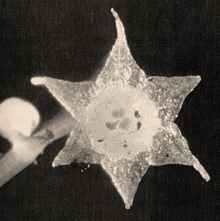Triuridaceae
| Triuridaceae | |
|---|---|
.jpg/440px-Sciaphila_secundiflora_Thwaites_ex_Benth.,_1855_錫蘭霉草_(19886718405).jpg)
| |
| Sciaphila secundiflora | |
| Scientific classification | |
| Kingdom: | Plantae |
| Clade: | Tracheophytes |
| Clade: | Angiosperms |
| Clade: | Monocots |
| Order: | Pandanales |
| Family: | Triuridaceae Gardner[1] |
| Genera | |
|
See text | |

Triuridaceae are a family of tropical and subtropical flowering plants, including nine genera with a total of approximately 55 known species.[2] All members lack chlorophyll and are mycoheterotrophic (obtain food by digesting intracellular fungi, often erroneously called 'saprophytes'). The heterotrophic lifestyle of these plants has resulted in a loss of xylem vessels and stomata, and a reduction of leaves to scales.[3]
The flowers of Triuridaceae have tepals which are fused at the base and contain 10 to many free carpels.
Systematics
The circumscription of Triuridaceae has been unstable and some taxa may be paraphyletic.[4][5]
Triuridaceae have been allied with Alismataceae (based on the free carpels) but the APG III system (2009) places them among the non-commelinid monocots, in the Order Pandanales.
The genus Lacandonia is sometimes placed in its own family, Lacandoniaceae.[3][6]
Triuridaceae are included in the Kew Royal Botanical Garden World Checklist of Selected Plant Families and were reviewed by H. Maas-van de Kamer and P. Maas-van de Kamer in 2005.[7] In this list, the genera Andruris and Hyalisma are subsumed into Sciaphila and Hexuris is subsumed into Peltophyllum, but two new genera Kupea and Kihansia are included. Both genera were described (and placed in Triuridaceae) in 2003. Mabelia and Nuhliantha are fossil genera that were both described in 2002 from the Turonian of New Jersey.[8] The included genera therefore are:
- Kihansia Cheek
- Kupea Cheek & S.A.Williams
- Lacandonia E.Martínez & Ramos
- †Mabelia Gandolfo, Nixon et Crepet
- †Nuhliantha Gandolfo, Nixon et Crepet
- Peltophyllum Gardner (syn. Hexuris Miers)
- Sciaphila Blume (syn. Hyalisma Champion)
- Seychellaria Hemsl.
- Soridium Miers
- Triuridopsis H.Maas & Maas
- Triuris Miers
| Triuridaceae | |
References
- ^ Angiosperm Phylogeny Group (2009). "An update of the Angiosperm Phylogeny Group classification for the orders and families of flowering plants: APG III". Botanical Journal of the Linnean Society. 161 (2): 105–121. doi:10.1111/j.1095-8339.2009.00996.x. hdl:10654/18083.
- ^ Christenhusz, M. J. M. & Byng, J. W. (2016). "The number of known plants species in the world and its annual increase". Phytotaxa. 261 (3). Magnolia Press: 201–217. doi:10.11646/phytotaxa.261.3.1.
- ^ a b "Neotropical Triuridaceae". Kew Royal Botanical Gardens. Retrieved 2012-10-31.
- ^ "Triuridaceae in APG III". Retrieved 2012-10-31.
- ^ Maas-van de Kamer, H.; T. Weustenfeld (1998). Kubitzki, K. (ed.). The Families and Genera of Vascular Plants Vol. 3. Berlin, Germany: Springer-Verlag. ISBN 3-540-64060-6.
- ^ Martinez, E.; C.H. Ramos (1989). "Lacandoniaceae (Triuridales): Una nueva familia de Mexico". Annals of the Missouri Botanical Garden. 76 (1): 128–135. doi:10.2307/2399346. JSTOR 2399346.
- ^ "Triuridaceae". World Checklist of Selected Plant Families. Kew Royal Botanical Garden. Retrieved 2012-10-31.
- ^ Gandolfo, M. A.; Nixon, K. C.; Crepet, W. L. (2002-12-01). "Triuridaceae fossil flowers from the Upper Cretaceous of New Jersey". American Journal of Botany. 89 (12): 1940–1957. doi:10.3732/ajb.89.12.1940. ISSN 0002-9122. PMID 21665623.
External links
- Triuridaceae Archived 2021-04-19 at the Wayback Machine in L. Watson and M.J. Dallwitz (1992 onwards). The families of flowering plants Archived 2007-01-03 at the Wayback Machine: descriptions, illustrations, identification, information retrieval. http://delta-intkey.com Archived 2007-01-03 at the Wayback Machine
- Monocot families (USDA)
- The specialists at work
- photograph of Sciaphila
- photographs of Sciaphila ramosa
- photographs of Sciaphila megastyla Archived 2007-03-11 at the Wayback Machine
- type of Sciaphila tosaensis
- NCBI Taxonomy Browser
- links at CSDL, Texas